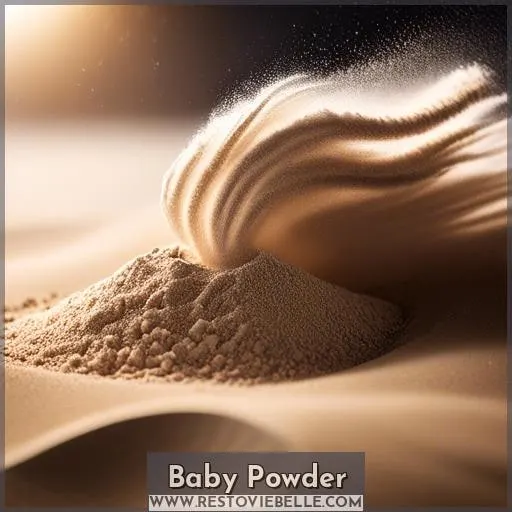This site is supported by our readers. We may earn a commission, at no cost to you, if you purchase through links.
 Just like the ancient Greeks found ingenious ways to solve seemingly insurmountable problems, you too can conquer the stubborn challenge of removing sand from your hair after a blissful day at the beach.
Just like the ancient Greeks found ingenious ways to solve seemingly insurmountable problems, you too can conquer the stubborn challenge of removing sand from your hair after a blissful day at the beach.
Whether it’s the fine grains that cling to every strand or the coarse bits that seem to have made a permanent home in your locks, there’s no need to despair. This guide will walk you through six proven methods, from the simplicity of shaking and blow-drying to the surprising effectiveness of baby powder and even a vacuum cleaner.
Say goodbye to the frustration of sandy hair and hello to mastering this beach lover’s dilemma with ease and confidence.
Yes, to get sand out of hair, you can rinse it in the shower or use baby powder to absorb moisture and loosen the sand before shaking it out and shampooing.
Table Of Contents
- Key Takeaways
- Shake and Blow Dry
- Comb and Shake
- Baby Powder
- Vacuum Your Hair
- Wash Your Hair
- Avoid Getting Sand in Your Hair
- Frequently Asked Questions (FAQs)
- How can I prevent sand from getting into my hair in the first place when visiting the beach?
- Is there a specific type of shampoo or hair product recommended for removing sand more effectively?
- Can certain hair types or textures, like curly or coily hair, require different or additional steps for effective sand removal?
- What are the long-term effects of frequently getting sand in your hair, and how can one mitigate any potential damage?
- Are there any professional salon treatments recommended for those who frequently struggle with sand in their hair from beach activities?
- Conclusion
Key Takeaways
- Physical removal methods like shaking the head, using a hairdryer on a cool setting, and combing with a wide-tooth comb can be effective for dislodging sand from hair.
- Wetting the hair and massaging the scalp can help loosen and remove sand particles, followed by thorough rinsing and possibly repeating the shampooing process.
- Baby powder can be applied to the hair and scalp to absorb oil and loosen sand, which can then be combed out, with the option to rinse afterward to remove any powder residue.
- For stubborn sand, using a vacuum with suction control can remove sand from the hair, especially when other methods are not suitable or have not been fully effective.
Shake and Blow Dry
When it comes to removing sand from your hair after a beach day, the Shake and Blow Dry method stands out as both effective and gentle. First, give your head a good shake. This initial step helps dislodge larger sand particles, making the subsequent steps more effective.
Next, grab your hairdryer, but here’s the key: set it to a cool temperature. Using a blow dryer on a cool setting is crucial for a couple of reasons. Firstly, it prevents hair damage. Heat can be harsh on your strands, leading to dryness, brittleness, and breakage.
By opting for the cool setting, you minimize the risk of damaging your hair while still effectively blowing away the sand particles. Secondly, the cool air is more comfortable on your scalp, especially if it’s already a bit sensitive from sun exposure.
The technique is straightforward yet requires a bit of finesse. Start by targeting the areas where sand is most stubbornly stuck. As you blow dry, use your fingers to gently separate your hair strands, allowing the cool air to reach deeper and dislodge the sand.
This method isn’t only effective but also gives you the chance to gently massage your scalp, promoting circulation and hair health.
In summary, the Shake and Blow Dry method, with its emphasis on using a cool temperature setting, offers a safe and efficient way to remove sand from your hair. It’s a testament to the power of combining simple physical actions with the thoughtful use of everyday tools to achieve clean, sand-free hair without the risk of damage.
Comb and Shake
Removing sand from hair, especially after a beach visit, can be a challenging task. However, with the right techniques, it’s possible to effectively eliminate sand without causing damage to your hair. One such method is the Comb and Shake technique, which is both gentle and efficient.
Firstly, it’s essential to start with wet hair. Wetting your hair makes it easier to dislodge the sand particles. Once your hair is wet, gently shake your head from side to side and then flip it over to shake some more.
Next, use your hands to further loosen any sand by running your fingers through your hair, focusing on the roots and scalp. This action helps to dislodge sand that’s clinging to your hair strands and scalp.
For a more thorough removal, employ a wide-tooth comb. Begin at the ends of your hair and carefully work your way up to the roots. The wide-tooth comb is particularly effective because it detangles without pulling too hard on your hair, which minimizes breakage and discomfort.
This tool is especially beneficial for wet hair as it can smooth and detangle with less resistance, leading to less damage.
If you encounter stubborn sand particles, a scalp massage can be beneficial. Use your fingertips to gently massage your scalp in a circular motion. This not only helps to remove sand but also promotes hair health by stimulating blood flow to the scalp.
After combing and massaging, give your hair another gentle shake to remove any loosened sand particles. This combination of wetting, shaking, combing, and scalp massaging is an effective way to rid your hair of sand without causing damage.
Baby Powder
After shaking out the loose grains and combing through your tresses, you might still find yourself in a gritty situation. But don’t fret—baby powder could be your unexpected ally in the battle against stubborn sand.
This household staple, known for its moisture-absorbing properties, can also help release sand’s grip on your hair.
Here’s how to use baby powder to your advantage:
- Apply Sparingly: Sprinkle a small amount of baby powder onto your scalp and through your hair. Remember, a little goes a long way.
- Work it Through: Gently massage the powder into your roots and hair. This helps to absorb oil and loosen the sand.
- Comb it Out: Use a wide-tooth comb to help remove the sand from your hair. The powder should make it easier for the grains to slide out.
- Brush and Style: After combing, brush your hair to remove any remaining powder and sand. This also helps to restore your hair’s natural look.
- Rinse if Needed: If you find any powder residue, a quick rinse with water can help clear it out.
While baby powder can be a quick fix, it’s important to consider the type of hair you have. Those with curly, coily, or kinky hair might find that baby powder, or its alternatives like dry shampoo, can help refresh their locks without the need for immediate washing.
However, be mindful of the brands you choose, as some may contain talc, which has been linked to health risks. For a safer option, look for talc-free baby powder or consider using cornstarch or arrowroot powder as natural alternatives.
Vacuum Your Hair
After using baby powder to loosen the grip of sand on your hair, you might still find some stubborn grains clinging on. If that’s the case, vacuuming your hair could be a surprising yet effective method to consider.
When opting for this technique, it’s crucial to have suction control to prevent any hair damage. For those with short hair or hair tied back in a ponytail, vacuuming can be particularly convenient. However, always test the suction force before using it on your hair to avoid any painful tugging or detangling issues.
Before you start, remove as much sand as possible by shaking out your hair or using a wide-tooth comb. Then, if you decide to vacuum, position the hose close to your head and turn on the vacuum. The suction should help lift the sand out of your hair. Be cautious not to let the vacuum pull too hard or get too close to your scalp.
After vacuuming, it’s a good idea to follow up with a thorough shampoo and conditioner routine to ensure all the sand is out and your hair is clean. For those with braids, you might want to use a compressed air spray to gently blow away sand particles without disturbing your hairstyle.
Remember, the goal is to remove the sand without causing any damage to your hair.
Wash Your Hair
When it comes to washing your hair after a beach day, it’s not just about getting rid of the saltwater. Sand, that sneaky stowaway, can be a real nuisance. But don’t worry, there’s a way to tackle it that’s both effective and kind to your locks.
First off, before you even think about turning on the tap, do your best to shake out as much sand as possible. This isn’t just about preserving your hairstyle; it’s about avoiding a clogged drain.
Now, onto the washing part. You’ll want to start with lukewarm water. Too hot, and you risk drying out your hair; too cold, and you won’t effectively remove the oils and sand. Thoroughly wet your hair, then apply a mild shampoo. Here’s where a little scalp massage can work wonders.
Not only does it feel great, but it also helps loosen the sand. Pay extra attention to the nape of your neck and behind your ears, as sand loves to hide there.
Rinse thoroughly. If you still feel gritty bits, don’t hesitate to repeat the shampooing process. Once you’re confident the sand is out, it’s time for conditioner. Opt for a moisturizing or deep conditioner to replenish any moisture lost to the sun and sea.
Finally, when it comes to drying your hair, be gentle. A soft towel pat-down followed by air drying or a low-heat blow-dry will do the trick. Remember, your hair’s been through a lot, so treat it with care. With these steps, you’ll not only remove the pesky sand but also keep your hair healthy and looking great.
Avoid Getting Sand in Your Hair
After washing your hair to remove any lingering sand, it’s crucial to focus on prevention.
-
Wear a Hat or Use a Scarf: A simple yet effective barrier against sand. Whether you opt for a wide-brimmed hat or a stylish scarf, covering your hair can significantly reduce the amount of sand that gets caught in it. Plus, it protects your scalp from the sun’s harmful rays.
-
Apply Oil to Your Hair: Before hitting the beach, apply a light layer of hair oil. This creates a slick barrier that makes it harder for sand to stick to your hair strands. Oils like coconut or jojoba are great options that also nourish your hair.
-
Braid Your Hair or Tie It Back: Loose hair acts like a magnet for sand, especially on windy days. By braiding your hair or tying it back in a ponytail, you minimize the surface area exposed to sand. This not only keeps your hair cleaner but also prevents tangles.
-
Keep Electronics in a Ziplock Bag: While not directly related to your hair, keeping your phone and other electronics in a ziplock bag can prevent sand from getting into small crevices. This tip helps you avoid the frustration of sand-related damage to your devices, allowing you to focus more on enjoying the beach and less on cleaning up afterward.
By implementing these strategies, you can significantly reduce the amount of sand that finds its way into your hair. Remember, prevention is key, and a little preparation goes a long way in ensuring your beach days are filled with fun, not frustration.
Frequently Asked Questions (FAQs)
How can I prevent sand from getting into my hair in the first place when visiting the beach?
To prevent sand from getting into your hair at the beach, consider wearing a tight-fitting cap or tying your hair up.
Applying a leave-in conditioner or oil can also create a barrier that makes it harder for sand to stick.
Is there a specific type of shampoo or hair product recommended for removing sand more effectively?
While it might seem like a regular shampoo should do the trick, when it comes to removing sand, a clarifying shampoo is your best bet. These shampoos contain a higher concentration of surfactants, which are cleansing agents that can more effectively remove the stubborn grains of sand from your hair.
Clarifying shampoos are designed to deep clean, removing not just sand but also product buildup, oil, and other residues that regular shampoos might leave behind. So, if you’re battling with sand stuck in your locks, reach for a clarifying shampoo for a thorough cleanse.
Can certain hair types or textures, like curly or coily hair, require different or additional steps for effective sand removal?
Curly or coily hair types often need extra care when removing sand due to their texture and susceptibility to dryness and breakage.
Gentle shaking, using a wide-tooth comb, and moisturizing treatments can help.
What are the long-term effects of frequently getting sand in your hair, and how can one mitigate any potential damage?
Frequent encounters with sand can lead to a gentle caress of wear on your hair, subtly whispering tales of dryness and potential breakage.
To shield your cherished locks from these whispered tales, consider embracing a ritual of thorough washing with a clarifying shampoo, followed by the tender embrace of a moisturizing conditioner or mask.
This loving care will ensure your hair remains a testament to resilience and beauty amidst the adventures.
Are there any professional salon treatments recommended for those who frequently struggle with sand in their hair from beach activities?
For those frequently battling sand in their hair from beach outings, professional salon treatments can offer relief.
Consider a deep conditioning treatment to restore moisture and strength, or a scalp treatment to address any irritation or buildup.
These services not only rejuvenate your hair but also prevent potential damage from persistent sand exposure.
Conclusion
Gone are the days when a beach outing meant accepting the gritty souvenir of sand in your hair as an inevitable aftermath. With these six proven methods, you’re now equipped to tackle even the most stubborn grains with confidence.
Whether you’re shaking and blow-drying away the loose particles, combing through to catch the strays, employing baby powder for its moisture-absorbing magic, or even resorting to a vacuum for a thorough cleanse, you’ve got the tools at your disposal.
So, as you master how to get sand out of hair, you’re not just solving a pesky problem—you’re reclaiming the joy of beach days, unmarred by the aftermath.











